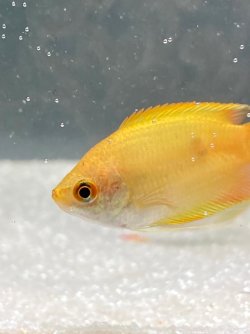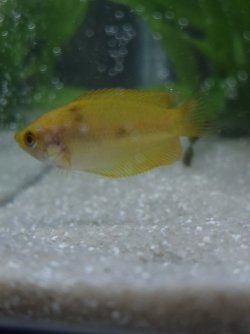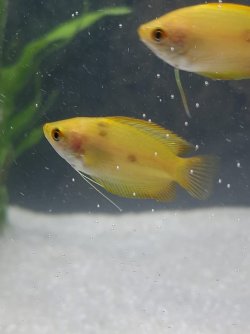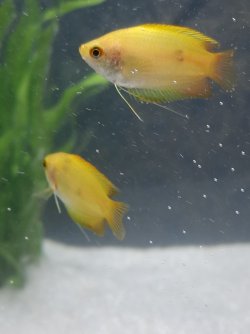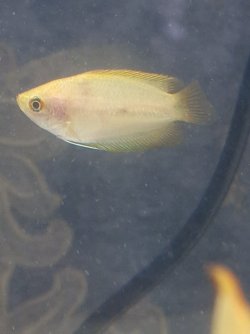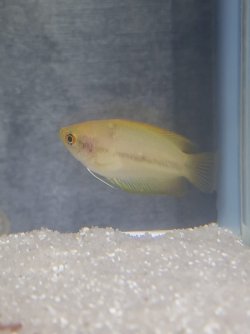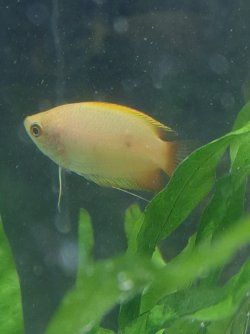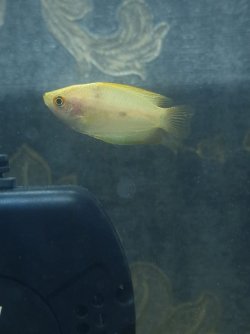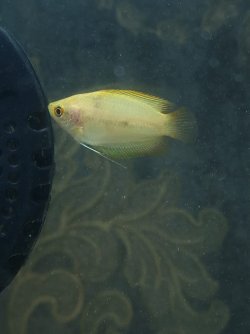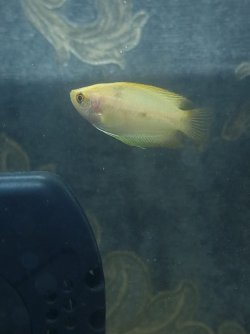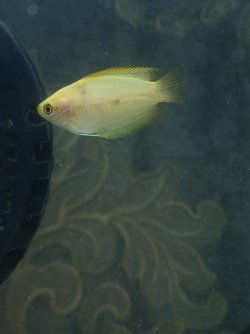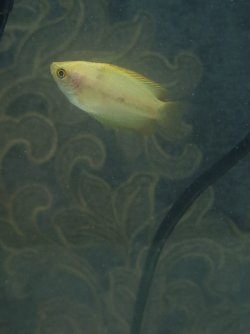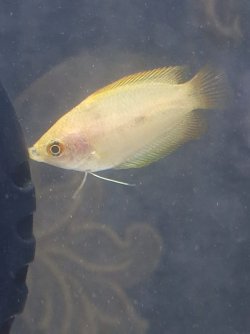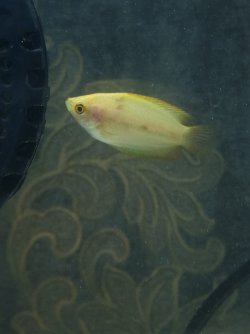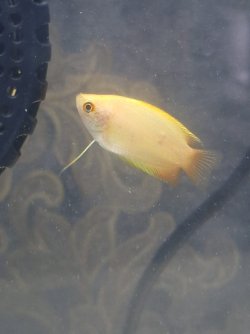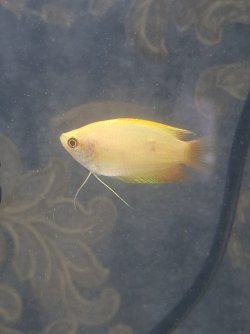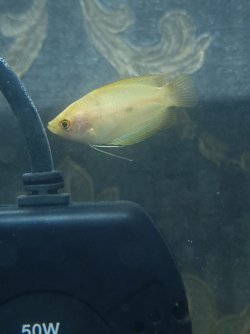Kirysek
New Member
Hi all!
Maybe anyone here would have any advice or seen anything similar... We bought 3 honey gourami from a local aquatic store. When we were buying them, a guy in a store changed one of them since he noticed white patch on its side. Rest of them looked good in the store. When at home, we put them in a quarantine tank before adding them to our cherry barbs and corydoras tank. When I examined them in good light in the QT I noticed dark/brown dots (quite round but not perfectly round) under their skin (it is visible on one side of the fish and especially when it swims in front of light so I can see through it a bit.) 2 out of 3 have those. One of gouramis has two of those dots a bit under the start of its dorsal fin and a third dot on its spine height in 1/3 of a length of a body. Second gourami has the same dots under skin above and under spine area also around ⅓ of a body length, also visible from one side.
We searched internet for something similar but there is not much, the most similar case visually that we found is a single post on reddit with not much interest in it but from what the author of the post was saying - he decided to do a dissection and found something worm-like surrounded by brown/black goo.
Our gouramis seem to be okay with their behaviour and are eating and swimming properly. After reading this reddit post and asking for the advice from the aquatic store (they said they can change them for different ones if we want to and they said that they have never seen anything like that) we decided to keep them and treated them for parasites as there was a chance it could be caused by flukes. After 2-3 days of treatment (anti-fluke & wormer, Contents: Flubendazole) we started to notice a bit of the dark spots clearing itself. Now we could see like a transparent bubble with a bit of dark remainings on the sides on some of the spots under the skin - so we thought it’s helping and maybe the body started dissolving whatever it was. But after another few days it seems to not get any better. Also a few days into treatment one of the gouramis had almost an invisible string like tissue(?) (around 1.5-2 cm) coming out of its body (next to the beginning of its dorsal fin). We dabbed it with Methylene Blue and we haven't seen anything like that again on any of them.
And now we started thinking more on that - is the treatment not the right one?
We remembered there was a white patch on one of the gouramis in the store and now we thought - was it Columnaris? Especially after finding this string-like tissue coming out of the fish? And if it was there are few ways Columnaris can go - and we found out that there is something like Black Patch Necrosis that is quite rare. ’Black necrotic tissue is formed when healthy tissue dies and becomes dehydrated, typically as a result of local ischemia.’ So can it be any form of Columnaris getting to that stage?
We are monitoring the water parameters with API test kit and have them with a filter (media in it taken from a fully cycled filter from another tank) and an air pump. Added a little plant so they can feel a bit more secure.
Some of their poo is looking okay, then some of it is more stringy, long and uneven in colour and form.
Anyway, Does anyone have any other ideas? Is there any treatment that comes to your mind? Has anyone ever seen something like that on gourami or any other fish?
We are on the 2nd week of treatment with Flubendazole, also based in the UK so have limited access to some meds specifically with antibiotics.
And sorry for the length - I just thought it may be better to say too much than too little.
We really want to help those little buddies. Added pics, hope they are visible
Cheers!
Maybe anyone here would have any advice or seen anything similar... We bought 3 honey gourami from a local aquatic store. When we were buying them, a guy in a store changed one of them since he noticed white patch on its side. Rest of them looked good in the store. When at home, we put them in a quarantine tank before adding them to our cherry barbs and corydoras tank. When I examined them in good light in the QT I noticed dark/brown dots (quite round but not perfectly round) under their skin (it is visible on one side of the fish and especially when it swims in front of light so I can see through it a bit.) 2 out of 3 have those. One of gouramis has two of those dots a bit under the start of its dorsal fin and a third dot on its spine height in 1/3 of a length of a body. Second gourami has the same dots under skin above and under spine area also around ⅓ of a body length, also visible from one side.
We searched internet for something similar but there is not much, the most similar case visually that we found is a single post on reddit with not much interest in it but from what the author of the post was saying - he decided to do a dissection and found something worm-like surrounded by brown/black goo.
Our gouramis seem to be okay with their behaviour and are eating and swimming properly. After reading this reddit post and asking for the advice from the aquatic store (they said they can change them for different ones if we want to and they said that they have never seen anything like that) we decided to keep them and treated them for parasites as there was a chance it could be caused by flukes. After 2-3 days of treatment (anti-fluke & wormer, Contents: Flubendazole) we started to notice a bit of the dark spots clearing itself. Now we could see like a transparent bubble with a bit of dark remainings on the sides on some of the spots under the skin - so we thought it’s helping and maybe the body started dissolving whatever it was. But after another few days it seems to not get any better. Also a few days into treatment one of the gouramis had almost an invisible string like tissue(?) (around 1.5-2 cm) coming out of its body (next to the beginning of its dorsal fin). We dabbed it with Methylene Blue and we haven't seen anything like that again on any of them.
And now we started thinking more on that - is the treatment not the right one?
We remembered there was a white patch on one of the gouramis in the store and now we thought - was it Columnaris? Especially after finding this string-like tissue coming out of the fish? And if it was there are few ways Columnaris can go - and we found out that there is something like Black Patch Necrosis that is quite rare. ’Black necrotic tissue is formed when healthy tissue dies and becomes dehydrated, typically as a result of local ischemia.’ So can it be any form of Columnaris getting to that stage?
We are monitoring the water parameters with API test kit and have them with a filter (media in it taken from a fully cycled filter from another tank) and an air pump. Added a little plant so they can feel a bit more secure.
Some of their poo is looking okay, then some of it is more stringy, long and uneven in colour and form.
Anyway, Does anyone have any other ideas? Is there any treatment that comes to your mind? Has anyone ever seen something like that on gourami or any other fish?
We are on the 2nd week of treatment with Flubendazole, also based in the UK so have limited access to some meds specifically with antibiotics.
And sorry for the length - I just thought it may be better to say too much than too little.
We really want to help those little buddies. Added pics, hope they are visible
Cheers!

